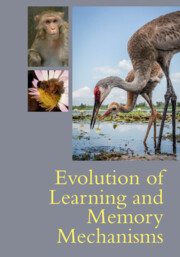Book contents
- Evolution of Learning and Memory Mechanisms
- Evolution of Learning and Memory Mechanisms
- Copyright page
- Contents
- Figures
- Tables
- Contributors
- Preface
- Introduction
- Part I Evolution of Learning Processes
- Part II Evolution of Memory Processes
- 16 The Evolution of Memory as an Immediate Perceptual Identification Mechanism
- 17 Episodic Memory in Animals
- 18 Evolutionary Origins of Complex Cognition
- 19 Evolution of Memory Systems in Animals
- 20 What Laboratory and Field Approaches Bring to Bear for Understanding the Evolution of Ursid Cognition
- 21 Distinguishing Mechanisms of Behavioral Inhibition and Self-control
- 22 Metacognitive Monitoring and Control in Monkeys
- 23 Adaptive Memory
- 24 Remembering Cheaters
- 25 Development of Memory Circuits under Epigenetic Regulation
- 26 Constraints on Learning and Memory
- Index
- References
26 - Constraints on Learning and Memory
A Resolution
from Part II - Evolution of Memory Processes
Published online by Cambridge University Press: 26 May 2022
- Evolution of Learning and Memory Mechanisms
- Evolution of Learning and Memory Mechanisms
- Copyright page
- Contents
- Figures
- Tables
- Contributors
- Preface
- Introduction
- Part I Evolution of Learning Processes
- Part II Evolution of Memory Processes
- 16 The Evolution of Memory as an Immediate Perceptual Identification Mechanism
- 17 Episodic Memory in Animals
- 18 Evolutionary Origins of Complex Cognition
- 19 Evolution of Memory Systems in Animals
- 20 What Laboratory and Field Approaches Bring to Bear for Understanding the Evolution of Ursid Cognition
- 21 Distinguishing Mechanisms of Behavioral Inhibition and Self-control
- 22 Metacognitive Monitoring and Control in Monkeys
- 23 Adaptive Memory
- 24 Remembering Cheaters
- 25 Development of Memory Circuits under Epigenetic Regulation
- 26 Constraints on Learning and Memory
- Index
- References
Summary
We review a selective history of the literature on related concepts such as belongingness, selective associations, and constraints on learning, as well as evidence for general learning processes. We then review the more recent and nascent literature on adaptive memory specializations in humans, vis-a-vis general models of memory. Following this introduction, we propose two insights that resolve the tension between general processes of learning and memory, on the one hand, and adaptive specializations, on the other. In the first insight, we use the analogy of how the general processes of DNA transcription and translation produce adaptively specialized proteins that are cell- and tissue-specific to serve as a model for understanding how learning and memory processes can reflect a common process at one level of analysis (e.g., cell-molecular) and adaptive specializations at another level of analysis (e.g., neural circuitry). The second insight comes from understanding how similarities in behavioral phenomena can arise due to shared ancestry (homology) or convergent evolution (homoplasy). These insights promise to unite psychological explanations of behavior with the rest of biology.
Keywords
- Type
- Chapter
- Information
- Evolution of Learning and Memory Mechanisms , pp. 454 - 472Publisher: Cambridge University PressPrint publication year: 2022



